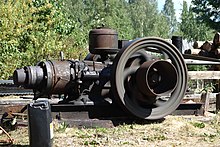Single cylinder engine
The single-cylinder engine is a type of internal combustion engine . Both gasoline engines ( two-stroke and four-stroke ) and diesel engines (two-stroke and four-stroke) are designed in the simplest form as single cylinders. The hot-head motor is also a single cylinder. The cylinder can be installed standing, lying or inclined.
history
The first reciprocating pistons were safely used in pumps , then in steam engines , and later in internal combustion engines . All of these uses started with the use of a single cylinder.
Advantages and disadvantages

The advantages over those of a multi-cylinder engine are u. a. a simpler structure, a more compact design and lower engine weight, but with a lower liter output, more complex sound absorption (both intake and exhaust side) and more difficult vibration compensation. Balance shafts and the crankshaft cheeks cast counterweights must because of the large crowds - and piston fail motions as overweight. Often, however, the driven part is also used for this, such as B. propellers or lawn mower blades.
The single-cylinder engine can be expected to be more efficient than a multi-cylinder engine of the same displacement, especially at low speeds . The reasons for this are fewer frictional losses in bearings and on piston rings, as well as lower thermal losses due to the smaller cylinder inner surface relative to the displacement. At very high speeds, on the other hand, single-cylinder engines have disadvantages, since compared to a multi-cylinder engine, the mean piston speed is greater, the moving masses are greater and the cross-sectional areas of the valves, which are small in relation to the stroke volume, increase the flow losses.
One disadvantage is that the engine runs out of round with greater speed uniformity, due to only one working cycle per 360 ° (two-stroke) or 720 ° crank angle (four-stroke). A more even runout is often achieved with a high flywheel, sometimes in the form of an additional flywheel. The engine weight increases disproportionately. In single-cylinder applications where the vibrations would be too annoying and where light weight and lively throttle response are important, e.g. B. with four-stroke motorcycles, a significantly improved concentricity according to the state of the art is achieved with one (e.g. KTM Duke 390) or even two balance shafts (KTM Duke 690 from model year 2016). Balance shafts are rarely found on two-stroke motorcycles (e.g. Aprilia 125 or KTM 250EXC TPI).
Use of single cylinder engines
Some early automobiles, such as the 1906 Cadillacs Model K and 1907 Model L and M used single cylinders. The Indian licensed manufacture of the Tempo three-wheeler from the 1950s had a single-cylinder diesel engine from 1978 until production was discontinued in 2000. The most common design is now sure the 50 cc - two-stroke - gasoline engine , which is installed in countless bicycles and in many countries made possible the mass motorization.
The single-cylinder is also used in the commercial vehicle sector - primarily in work machines - in motor sports , in small-scale agriculture, in sailing and motor boats and in aircraft, and as a stationary industrial engine. Its use in motorcycles is just as important. The largest series-produced motorcycle single-cylinder with a displacement of 778 cm³ was the Suzuki DR 800 S , whose production was discontinued in 1998; the most powerful series motorcycle single cylinder is the KTM Duke 690 from model year 2016 with 75 hp. Larger single-cylinder engines were built for various motorcycle prototypes (up to almost two liters displacement) as well as for tractors. Almost all lawnmower motors on the market are single cylinder motors. Single cylinder engines are also used in research and development. These can be used to examine the combustion process and important components very well. The advantage here is the clear assignment. In addition, fewer sample parts are needed. The knowledge gained on the single-cylinder engine is then transferred to the planned multi-cylinder engine - referred to in mechanical engineering as "full engine".
In inland navigation , many single-cylinder diesel engines used to be used to drive anchor winches , compressors and hydraulically operated steering gear ("steering gear").
Lanz Bulldog (1928) with a single-cylinder glow-head motor
literature
- Peter Gerigk, Detlev Bruhn, Dietmar Danner: Automotive engineering. 3rd edition, Westermann Schulbuchverlag GmbH, Braunschweig, 2000, ISBN 3-14-221500-X
- Jan Drummans: The car and its technology. 1st edition, Motorbuchverlag, Stuttgart, 1992, ISBN 3-613-01288-X



